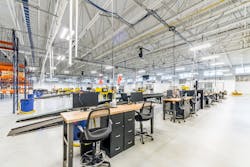Using Industrial Design to Improve Employee Experience
Factories have always been designed so that the floor plan was efficient for the processes taking place. But what if it was also designed for the efficiency of the employees?
“We have manufacturing companies asking us how we can design an industrial space that will be attractive to employees so that they will work for them as opposed to their competitor across the street,” explains Tammi Bailey, principal architect, JE Dunn Construction, which provides design-build services, general contracting and construction management.
The environment of a factory, or industrial space, is becoming more important to future employees as they choose companies. Given this has not traditionally been a top concern for manufacturers, views are shifting. “Especially coming out of the pandemic, everyone wants to feel a connection and wants to feel part of a community,” says Bailey. “Employees want to feel valued and important to an organization. When you enter a facility that more closely resembles a prison with gates and barbed wire, it doesn’t send that message. From the minute an employee enters a site there should be a positive feeling.”
And part of this positive image is to project equality. “Instead of the older version of one entrance for office workers and then a different one for production workers, there is now just one entry point. It sends the message of a united community,” states Bailey.
The interplay between inside space and outside space is also be reconsidered “The role that the natural environment plays in the physical design of the workplace is becoming more important and part of the design process,” says Bailey.
Technology continues to play an important role in ensuring that employees have a good working experience. “Technology is able to connect different functions within the physical environment that makes a job safer, easier, more efficient and more enjoyable,” says Mike Kettleson, west regional operations director for Aptitude, which is JE Dunn's technology partner.
Southeast Toyota Distributors Taps Into Employee Knowlege for Design
While incorporating design ideas specifically for employee engagement is new, the idea of incorporating the safety of employees in the design process is called prevention through design. The goal is to minimize occupational hazards early in the design process, with an emphasis on optimizing employee health and safety throughout the life cycle of materials and processes. Now companies are including employees early in the design process. This was exactly the route that Southeast Toyota Distributors took in conjunction with JE Dunn. The company; owned by JM Family Enterprises, decided to build a new facility rather than renovate an older site. As the world’s largest independent distributor of Toyota vehicles, Southeast Toyota, build a new state-of-the-art facility that was able to double the processing capacity at this facility to over 95,000 vehicles annually.When the company decided to build a new facility, which employs over 230 associates, they designed systems with associates in mind, including flexibility, adaptability, efficiency, community, a fun environment, and a comfortable work zone. These goals were used as a basis for decision-making throughout the project.
“JM Family takes our associates’ opinions and feedback into account when it comes to how we are physically constructing our future,” said Rick Jorden, director of construction real estate, JM Family Enterprises. “As with every project we embark on, when we launched the build-out of our automotive processing facility in Commerce, Georgia, we engaged with many associates to gain a complete look at the design project needs, while giving them early input into pain points of their existing facilities, process improvement suggestions and ideas on how to better the workspace and flow."
When comparing the new site to the older one, the company found several advantages to using this decision-making process:
- 50% reduction in vehicle touches
- 12% increase in processing efficiency
- 67% reduction in safety incidents, due largely to collaboratively thinking through the flow of vehicles through the facility before it was built.
“Through associate input, the company added specific amenities to improve work-life, including an updated Health Wellness Center and fitness center. Other features that were important to our associates were the expanded dining facility with ample outdoor seating, the community garden where associates can grow their own herbs, produce and flowers, the beautiful new water feature and fire pit, and the outdoor fitness trail which leads to a fishing pond, which we restored and stocked with fish. We were also able to accommodate their request to move associate parking closer to the worksite, and centralize the dining facility, making it easier for workers to enjoy a full 30-minute lunch break.”
Using employee input to ensure that the physical design of the facility offers a favorable experience is important to ensure engaged employees. “At the end of the day we want our employees to feel valued and supported in an environment where they can do their best work,” says Bailey.
